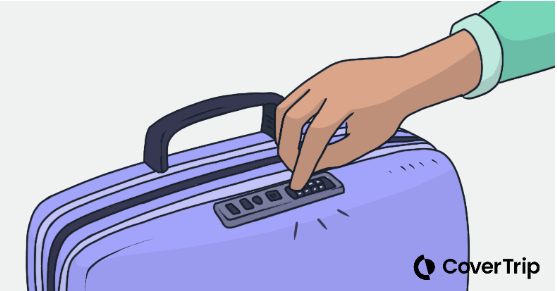How to Keep your Bags Safe When You Travel
25 April 2025
Today’s savvy travelers embrace simple yet effective strategies to protect their bags, from utilizing discreet tracking devices to choosing the right storage locations. Having a solid plan for securing belongings lets you focus on what matters most: enjoying your trip!
Whether planning a European train adventure or a cross-country flight, understanding how to protect your belongings is essential. It’s about peace of mind and maintaining control over your belongings.
By incorporating the following straightforward security measures into your travel routine, you can confidently navigate any transportation system or accommodation, knowing you’re prepared and you’ve taken smart steps to protect your belongings.
Let’s explore practical ways to keep your bags safe while maintaining the joy and spontaneity of travel.

Securing your bags on flights
There are times when a traveler doesn’t want to drag their suitcase. Ever-expanding airports give travelers extreme workouts as they race to catch their next flight. Travelers with mobility issues may find it simply easier to check their bags.
But whether you check your bag or not, you can’t guarantee it’s safe from thieves – here are some recent reports as examples:
- Denver Police are tracking luggage thieves at the Denver International Airport.
- Travelers are getting robbed on flights too: see the story of one traveler who got wise on the return flight.
- Luggage storage services aren’t entirely safe either – here’s a bizarre story about the Bounce app.
So, how do you protect your bags when traveling by plane?
If you check your bag
- Keep valuables and essentials in your carry-on
- Use a TSA-approved lock to secure your bag
- Take a photo of your bag and its contents before leaving
- Remove all previous flight tags to avoid routing confusion
- Put an AirTag or similar tracking device inside the lining of your suitcase
- Get to baggage claim quickly and verify your bag’s tag number before leaving
If you carry your bag onboard
If you carry your bags onboard, you will use many of the same techniques, including:
- Use a TSA-approved lock to secure your bag (yes, even if you plan to carry it on, because you may be asked to gate check it if the overhead bins are full)
- Take photos of your bag and its contents before leaving
- Remove all previous flight tags to avoid routing confusion
- Put a tracking device inside the lining of your suitcase
When stashing your bag before seating:
- Choose an overhead bin across the aisle from your seat and one row in front—this will allow you to more easily monitor it.
- Position your bag with the zippers facing the bin’s back wall, making it harder for thieves to quickly gain access to the contents.
When you leave your seat:
- Don’t leave electronics unattended in seat pockets – put them back in your personal item.
- Take your personal item with you so your seatmates don’t steal from it while you’re gone, or
- Lock it with a second TSA-approved lock and cable it to your seat frame.
That last part sounds extreme until you read stories like this one on Reddit:

Securing your bags on trains and buses
Travel by public transportation like trains and buses, presents unique security challenges. You’re dealing with multiple stops, passengers coming and going, and often lengthy journeys where vigilance can waver.
Here’s how to protect your belongings.
On transportation with luggage storage areas
- Lock your luggage – this works to deter or slow thieves down
- Choose a storage rack near your seat rather than at the end of the car
- Use a cable lock to secure your bag to the rack itself
- Position bags so you can see them from your seat
- Consider placing a small tracking device in your luggage
- Snap a quick photo of your bags in their storage location (this may be helpful if your bag is stolen and you need to report it to the conductor and police)
On transportation with storage at your seat
- Lock your luggage – this works to deter or slow thieves down
- Keep smaller bags and valuables with you at your seat
- Use under-seat storage rather than overhead bins when possible
- During lengthy or overnight trips, secure your bags to the luggage rack, your seat or sleeping berth with a locking cable
- Keep essential items (wallet, phone, documents) in a body-worn pouch
Pro tip: Stay alert during stops. Thieves often target bags during the confusion of passengers boarding and departing. This is why securing your bag to the luggage rack is a good idea.
Securing your bags at hotels and accommodations
Where you sleep is supposed to be a place of safety. Still, hotels and other types of lodging present the opportunity for experienced thieves: multiple access points, changing staff, and periods when you leave your bags behind to explore are up for grabs.
If you leave your bag with hotel security
The first rule is to never leave anything valuable (like large sums of cash, expensive electronics, or jewelry) in a bag that leaves your sight.
- Lock your luggage
- Take a photo of your bag before handing it over (this will be helpful if the staff changes and you need to remind someone what your bag looks like)
- Take a photo of your claim ticket in case it’s lost
When you leave your room
The first rule is to put that ‘do not disturb’ card on your door. If you need extra towels, you can ask for them at the front desk when you return.
- Lock your luggage
- Store valuables in the in-room safe, but test it first
- Keep your things closed and organized – this helps you notice if anything’s been disturbed
Note: If your in-room safe isn’t working, and you need to secure something of value, most hotels offer secure storage in the central hotel safe. Just get a written receipt for anything you store with them, and take a photo of the items and the receipt. You’ll have a backup if you lose the claim check or receipt. If your things are missing when you return and ask for them, you’ll have a photo to make a police report.
For shared accommodations
If you’re staying in hostels or other types of shared accommodations:
- Lock your luggage when you leave, and secure your luggage to your bed or other immovable object with a lock and cable
- Bring your own padlock for lockers
- Keep important documents and valuables on your person
Damian Tysdal is the founder of CoverTrip, and is a licensed agent for travel insurance (MA 1883287). He believes travel insurance should be easier to understand, and started the first travel insurance blog in 2006.
